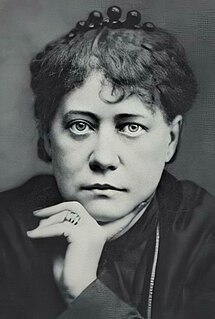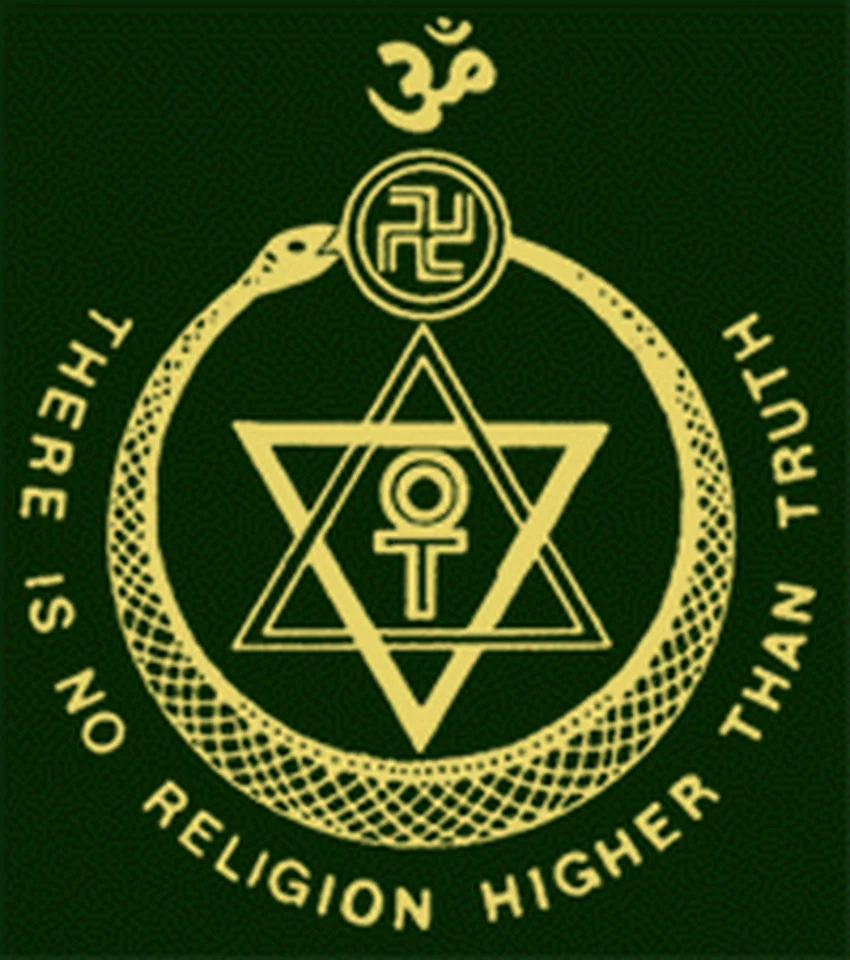
Helena Petrovna Blavatsky was a controversial Russian occultist, philosopher, and author who co-founded the Theosophical Society in 1875. She gained an international following as the leading theoretician of Theosophy, the esoteric movement that the society promoted.

The Theosophy Society – Adyar is the name of a section of the Theosophical Society founded by Helena Petrovna Blavatsky and others in 1882. In that same year, its headquarters moved with Blavatsky and president Henry Steel Olcott from New York to Adyar, an area of Chennai, India. The designation 'Adyar' is added to make it clear that this is the Theosophical Society headquartered there, after the American section and some other lodges separated from it in 1895, under William Quan Judge.

William Quan Judge was an Irish-American mystic, esotericist, and occultist, and one of the founders of the original Theosophical Society. He was born in Dublin, Ireland. When he was 13 years old, his family emigrated to the United States. He became a naturalized citizen of the USA at age 21 and passed the New York state bar exam, specializing in commercial law.

The Theosophical Society, founded in 1875, is a worldwide body with aim to advance the ideas of Theosophy in continuation of previous Theosophists, especially that of the Greek and Alexandrian Neo-Platonic philosophers dating back to 3rd century AD. It also encompasses wider religious philosophies like Vedānta, Mahāyāna Buddhism, Qabbalah, and Sufism.The Theosophical Society functions as a bridge between East and West, emphasizing the commonality of human culture.

Annie Besant was a British socialist, theosophist, women's rights activist, writer, orator, educationist, and philanthropist. Regarded as a champion of human freedom, she was an ardent supporter of both Irish and Indian self-rule. She was a prolific author with over three hundred books and pamphlets to her credit. As an educationist, her contributions included the founding of the Banaras Hindu University.

The United Lodge of Theosophists or ULT is an informal and wholly voluntary association of students of Theosophy. It was founded in 1909, mainly through the efforts of Robert Crosbie. The first parent lodge of the ULT was started in Los Angeles by Robert Crosbie and seven other associates through the adoption of its Declaration on February 18, 1909. Owing largely to the revival efforts of B.P. Wadia after Crosbie's death, there are currently about twenty active lodges spread all over the world. The ULT is considered to be part of the second generation or the third section of the Theosophical Movement started in 1875 by H.P. Blavatsky in New York. Presently, it is also one of the existing four main "branches" of the original Theosophical Movement. The following founding principles when taken as a whole, sets apart the ULT from the other Theosophical Organizations:

Robert Crosbie was a theosophist and founder of the United Lodge of Theosophists (ULT).

The Theosophical Society in America (TSA) is a member-based nonprofit organization dedicated to the teaching of Theosophy and affiliated with the international Theosophical Society based in Adyar, Chennai, India. The name "Theosophical Society in America" was legally adopted by the American Theosophical Society in 1934. Previously, other organizations had used the same name during the years 1895–98 and 1898–1908.

George Sidney Arundale was a Theosophist, Freemason, president of the Theosophical Society Adyar and A bishop of the Liberal Catholic Church. He was the husband of the celebrated Indian dancer Rukmini Devi Arundale.

Curuppumullage Jinarajadasa was a Sri Lankan author, occultist, freemason and theosophist. The fourth president of the Theosophical Society, Jinarajadasa was one of the world's foremost Theosophical authors, having published more than 50 books and more than 1600 articles in periodicals during his life. His interests and writings included religion, philosophy, literature, art, science and occult chemistry. He was also a rare linguist, who had the ability to work in many European languages.
Bahman Pestonji Wadia or Bomanji Pestonji Wadia was an Indian theosophist and labour activist. He was first a member of the TS Adyar, later of the United Lodge of Theosophists. On 13 April 1918, along with V. Kalyanasundaram Mudaliar, Wadia founded the Madras Labour Union, one of India's first organised labour unions.

The Theosophist is the monthly journal of the international Theosophical Society based in Adyar, India. It was founded in India in 1879 by Helena Blavatsky, who was also its editor. The journal is still being published till date. For the year 1930, the journal was published in Hollywood, California by Annie Besant and Marie Russak Hotchener, but it returned to Adyar in 1931. The journal features articles about philosophy, art, literature and occultism.

Theosophical teachings have borrowed some concepts and terms from Buddhism. Some theosophists like Helena Blavatsky, Helena Roerich and Henry Steel Olcott also became Buddhists. Henry Steel Olcott helped shape the design of the Buddhist flag. Tibetan Buddhism was popularised in the West at first mainly by Theosophists including Evans-Wentz and Alexandra David-Neel.
The Aryan Path was an Anglo-Indian theosophical journal published in Bombay, India, between 1930 and 1960. Its purpose was to form "a nucleus of universal brotherhood of humanity, without distinction of race, creed, sex, caste or color; to study ancient and modern religions, philosophies, and sciences, and to demonstrate the importance of such study". The magazine's first editor was B. P. Wadia. It was published on a bimonthly basis by a group called the Theosophy Company, which distributed copies of the magazine to London.

In Theosophy, the Maitreya or Lord Maitreya is an advanced spiritual entity and high-ranking member of a hidden Spiritual Hierarchy, the Masters of the Ancient Wisdom. According to Theosophical doctrine, one of the Hierarchy's functions is to oversee the evolution of humankind; in accord with this function the Maitreya is said to hold the Office of the World Teacher. Theosophical texts posit that the purpose of this Office is to facilitate the transfer of knowledge about the true constitution and workings of Existence to humankind. Humanity is thereby assisted on its presumed cyclical, but ever progressive, evolutionary path. Reputedly, one way the knowledge transfer is accomplished is by Maitreya occasionally manifesting or incarnating in the physical realm; the manifested entity then assumes the role of World Teacher of Humankind.
The Indian Institute of World Culture (IIWC), is a public institution that aims, via its activities, "to foster the growth of a truly cosmopolitan spirit among citizens of all nations." It is located on B.P Wadia Road in the Basavanagudi area of the city of Bengaluru, India, and was founded on 11 August 1945 by B. P. Wadia and his spouse, Sophia Wadia.
Sophia Wadia, née Sophia Camacho, was a Colombian-born naturalized Indian theosophist, littérateur, the founder of PEN All India Centre and the founder editor of its journal, The Indian PEN. She also cofounded The Indian Institute of World Culture, Bengaluru and the Asian Book Trust, Mumbai. The Government of India honoured Wadia in 1960, with the award of Padma Shri, the fourth highest Indian civilian award for her services to the nation.

Theosophy is a religion established in the United States during the late nineteenth century. It was founded primarily by the Russian immigrant Helena Blavatsky and draws its beliefs predominantly from Blavatsky's writings. Categorized by scholars of religion as both a new religious movement and as part of the occultist stream of Western esotericism, it draws upon both older European philosophies such as Neoplatonism and Asian religions such as Hinduism and Buddhism.

"What Are The Theosophists?" is an editorial published in October 1879 in the theosophical magazine The Theosophist. It was compiled by Helena Blavatsky and it was included the 2nd volume of the Blavatsky Collected Writings.

Hinduism is regarded by modern Theosophy as one of the main sources of "esoteric wisdom" of the East. The Theosophical Society was created in a hope that Asian philosophical-religious ideas "could be integrated into a grand religious synthesis." Prof. Antoine Faivre wrote that "by its content and its inspiration" the Theosophical Society is greatly dependent on Eastern traditions, "especially Hindu; in this, it well reflects the cultural climate in which it was born." A Russian Indologist Alexander Senkevich noted that the concept of Helena Blavatsky's Theosophy was based on Hinduism. According to Encyclopedia of Hinduism, "Theosophy is basically a Western esoteric teaching, but it resonated with Hinduism at a variety of points."















